Introduction
- The workplace is one of the factors that determine the performance of an organization.
- Employees who have basic workplace necessities have reported better workplace performance.
- The psychologically healthy workplace has also been the subject of many studies and surveys.
- Success and productivity of an organization is directly related to how well these organizations are able to manage employee issues that relate to mental health.
- The psychological health of employees is a challenge to most workplaces.
- Therefore, this presentation looks at a psychologically healthy workplace.
The workplace environment is one of the factors determining the performance of an organization. The workplace contributes to the output of employees through influencing their psychology. Employees that have basic workplace necessities have reported better workplace performance than those that do not have these. There are several other ways that a healthy workplace can be evaluated, in addition to positive performance.
Several surveys have been conducted on workplace performance in relation to the psychologically healthy workplace. The psychologically healthy workplace has also been the subject of many studies, which have produced different conclusions and observations.
According to Churchill, Gillespie, and Herbold (2014), the psychological health of employees is a challenge to most workplaces, with this situation being observed in all industries, organizations, and companies of any size. The development of interest in the psychological health of employees has led to the origin of many disciplines in business that are aimed at looking at the psychological health of employees. Most of these have, however, not managed to guarantee the psychological health of employees in the workplace, with the only achievement being improved working conditions.
According to Churchill, Gillespie and Herbold (2014), the success and productivity of an organization are directly related to how well these organizations are able to manage employee issues that relate to mental health. Despite the contribution of psychological health to employee performance, most discussions on employee performance have not been centred on the same subject.
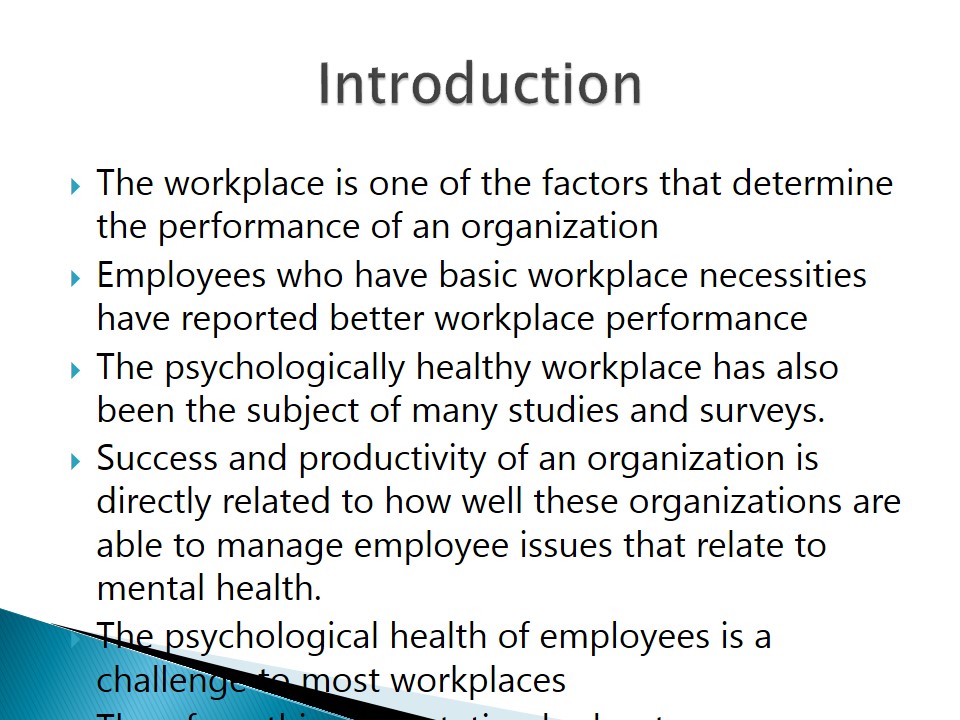
Principles of Psychologically Healthy Workplace
- Scholars have developed several principals that address the subject of psychologically healthy workplace.
- These principals are products of many years of research.
- Some of the principles of a psychologically healthy workplace include:
- Employee involvement;
- Work-life balance;
- Employee growth and development;
- Health & safety;
- Employee recognition;
- Communication.
For a workplace to be regarded as psychologically healthy, there are certain factors, characteristics, or principles that it should have. These are products of years of research, where researchers evaluated the performance of organizations based on these factors.
In most of the studies conducted on the principles of a psychologically healthy workplace, the researchers tested a particular principle against the performance of that particular organization, and proceeded to make appropriate conclusions based on their results.
Some researchers even listed some of the factors and principles that make up a psychologically healthy workplace. According to Queensland Government (2013), some of the principles of a psychologically healthy workplace include employee involvement, work-life balance, employee growth & development, health & safety, employee recognition and communication.
Most of the principles of a psychologically healthy workplace are universally accepted, and employers target to achieve them within their organizations. The reason behind the targeted achievement of the principles of psychological wellbeing in organizations is that employees recognize the role they play in enhancing productivity and performance of the individual employee.
However, several studies that have been conducted on the principles of workplace psychological wellbeing have shown that some of the principles are more theoretical than practical. Therefore, there is minimal change that is achieved in organizations even with these principles. This presentation focuses on some of the most important principles.
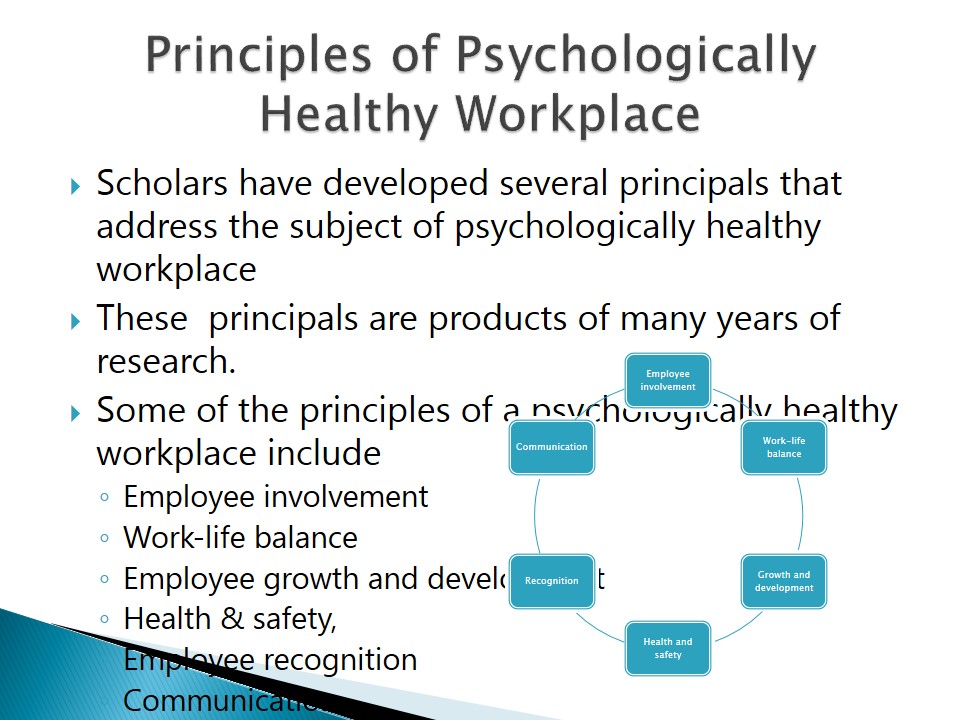
Employee involvement
- Employee involvement is one of the principles of a psychologically healthy workplace.
- Significant success in the use of this principle has also been demonstrated.
- Researchers observed that better performing organizations are those that involve their employees in all decisions.
- This strategy improves employee self-esteem and in effect their performance.
- Organizations are able to get feedback on some of the issues that affect them.
- Hence, they are able to improve on some areas that are in line with their key deliverables.
The graph shows the predicted relationship between employee performance and involvement in organizations.
Employee involvement is one of the principles of a psychologically healthy workplace. Most organizations have embarked on a campaign to involve their employees in activities that they are undertaking. Significant success in the use of this principle has also been demonstrated (Churchill, Gillespie, & Herbold, 2014).
In a research conducted on the performance of organizations in relation to the level of employee involvement at the organization, researchers observed that the better performing organizations are those that involve their employees in all decisions.
The involvement of employees in the major decisions of an organization assures them that they are the most important asset to the organization, hence this improves their self-esteem and in effect their performance. Major organizations have embraced employee programs that are aimed at ensuring their involvement in the decision making, with the result being improved performance of these organizations.
Research shows that employees who are involved in the affairs of an organization have a better motivation compared to those that do not get the same from their organizations. Most of the organizations that have involvement of employees are able to get feedback on some of the issues affecting them. Hence, they are able to improve on some of the areas. Therefore, involvement of employees in organizations can be said to be a way of obtaining feedback and ensuring improvement and performance.
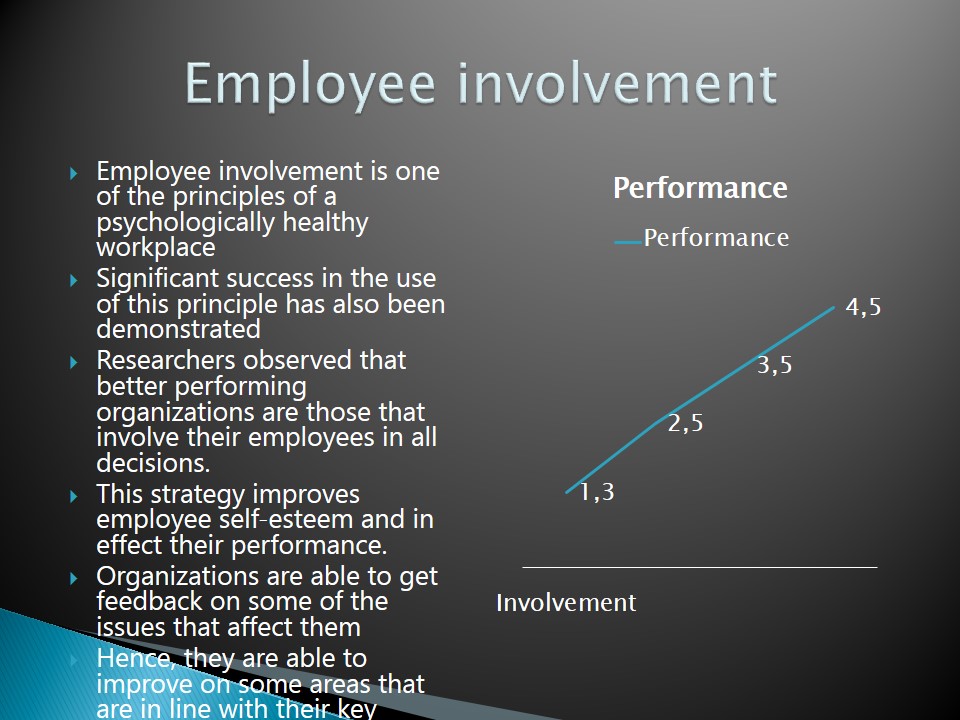
Work-life balance
- Human beings are social beings.
- Performance of most individuals is linked to their ability to balance the different aspects of their life.
- What people do with their time when they are not working greatly affects their output at work.
- Organizations should ensure that they allow their employees to undertake other activities outside of their workplaces.
- Organizations that do not give room for employees to attend to their crucial life matters do not perform well.
- Such employees feel denied their basic right.
- Hence, they fail to give maximum input.
Human beings are social beings who are affected by a variety of issues around them. The performance of most individuals is linked to their ability to balance the different aspects of their life, including the work and social lives.
All employees work in an organisation for a given number of hours during the day, with the rest of these hours being spent in other areas. According to Churchill, Gillespie, and Herbold (2014), what people do with their time when they are not working greatly affects their output at work. When an employee is unable to balance between work and other activities away from work, he or she ends up being poor performers.
Organizations can determine how well their employees are able to balance between their work life and other activities that they engage in outside of the work environment. An example is where an employee has to balance between family and the workplace. Employees who are unable to balance between the two end up reporting poor performance at the workplace, with the result being the poor performance of the organization that they are working for.
Organizations should ensure that they allow their employees to undertake other activities outside of their workplaces to ensure that they are better equipped to handle every situation that may arise at their work stations. By so doing, these organizations will be improving the psychological wellbeing of their employees.
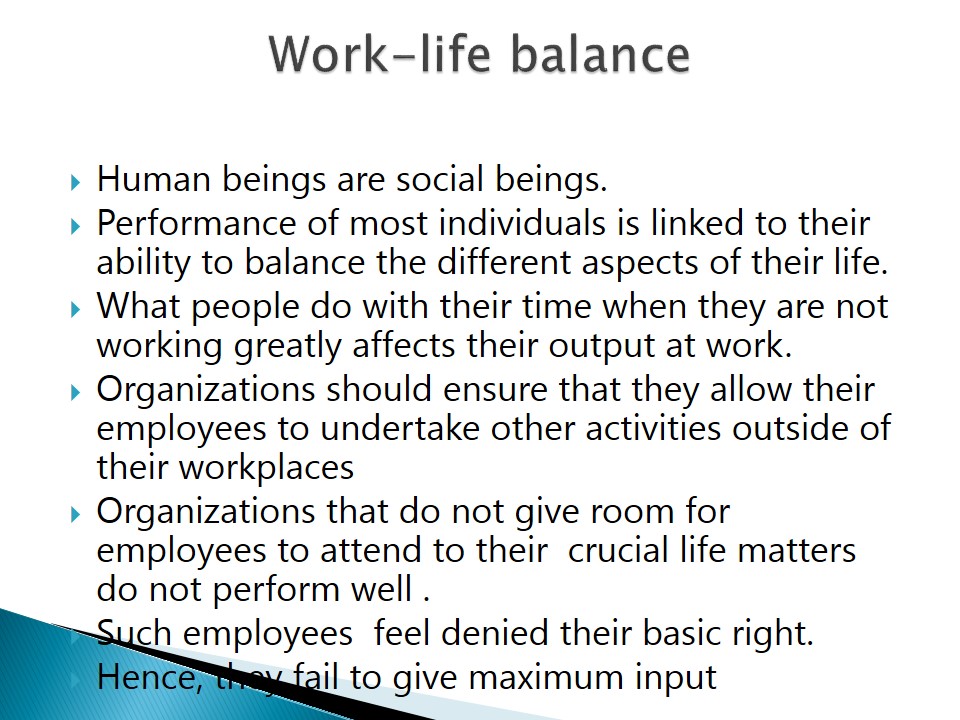
Employee growth & development
- Training programs are examples of employee growth and development.
- Growth and development of employees in organizations can be the main determining factor between success and failure.
- Researchers have shown that the performance of organizations is related to the growth and development activities that the organization instills in their employees.
- Organizations improve the skills of their employees in the process of training and development.
- Organizations that embark on the least growth and development activities for their employees often have poor performance.
Employee growth and development constitutes one of the areas that employers can maximize on to ensure improved performance at the workplace. The growth and development of employees, according to Churchill, Gillespie, and Herbold (2014), is one of the major principles of the psychological wellbeing of employees.
According to Churchill, Gillespie, and Herbold (2014), organizations frequently undertake activities that are meant to improve the performance of organizations, with growth and development of employees being the main areas of focus in most cases. Researchers have shown that the performance of organizations is related to the growth and development activities that the organization is instil in their employees.
Growth and development is an areas that is relevant to the employee and the organization as a whole. An examples of ways that organizations embark on the employee growth and development is through training programs. Organizations improve on the skill of their employees in the process of training and development. Research shows that employees trained by the organization have a better psychological wellbeing compared to their counterparts without the same experience.
According to Churchill, Gillespie, and Herbold (2014), the growth and development of employees in organizations can be the main determining factor between success and failure. Those organizations that embark on the least growth and development activities for their employees often have poor performance and showing in their sector, especially if there is absence of training and career development or the employees.
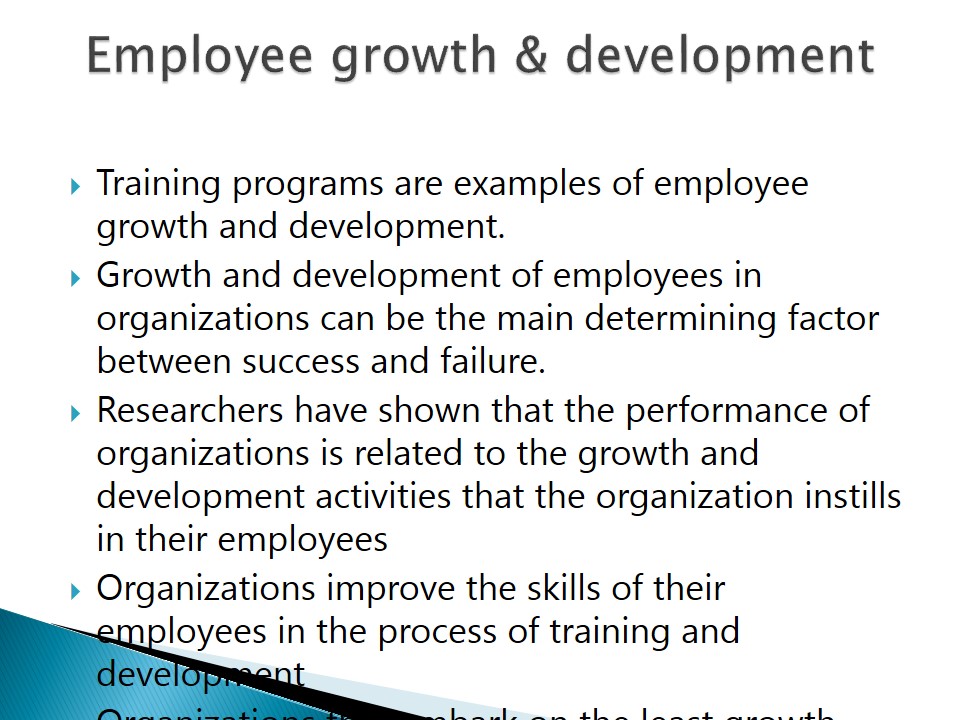
Health & safety
- Many laws exist on the health and safety of employees within the workplace.
- Local and international bodies are also charged with maintenance of health and safety at the workplace.
- The health of employees affects their output in terms of:
- Decreased capacity to provide services to their organization;
- High costs incurred by the organizations in the maintenance of a healthy workforce.
- Policies developed by the organizations in charge of the health and safety of employees are expected to be respected by all players in the concerned organizations.
- Occupational health and safety campaigns have been in place for a long time.
- Information from these campaigns has been useful in many organizations that have the health of their employees as a key determinant of their input and quality of work.
- The safety of the environment within which employees operate in contributes to their work output.
- Improved working conditions are among top demands for employees.
- Employers need to be party to the rules and regulations that govern the health and safety of their working environment.
- Authorities should embark on ensuring that health and safety regulations are respected through frequent inspection of workplaces.
- Numerous campaigns are aimed at sensitizing employees on their rights to safety and health in organizations.
- Campaigns can be a way of sensitizing employees on their safety and health.
The other principle that determines the performance of employees by affecting their psychological wellbeing is the health and safety that the organizations are able to maintain. Many laws exist on the health and safety of employees within the workplace. These laws are internationally crucial to the performance of employees, and determine the output that they give for their organizations.
Several bodies exist with the aim of guaranteeing the safety and healthy workplaces for employees on the local and international front. Some of the most critical of these organizations include the World health organization, which develops standards related to the health and safety of the general population. Local bodies charged with the maintenance of health and safety in organizations are created and protected by the law.
The policies developed by the organizations in charge of the health and safety of employees are expected to be respected by all the players in the organizations concerned. Occupational health and safety campaigns have been in place for long now, with many bodies emphasizing on the need for organizations to adopt this.
The health of employees affects their output in a number of ways. One is that sick employees have low concentration levels, with the result being the reduced performance of the businesses. The other effect is that there are high costs incurred by the organizations in the maintenance of a healthy workforce.
The safety of employees within the workplace constitutes an important factor in their performance in addition to health. The safety of the environment within which employees operate in contributes to their work output. A working environment that is not safe for employees is considered to be one of the factors causing poor performance in organizations.
The Employees have in the past participated in strikes and other activities that are aimed at sensitizing their employers non the poor working conditions. Among the most common demands made by striking workers is the provision of a safe working environment where they can conduct their activities without ease (Boston & Clifford, 2013). According to Boston and Clifford (2013), the commonest demand for striking workers is an improvement in the remuneration, with health and safety featuring high among this list.
There are several examples of how organizations may guarantee a safe and healthy environment for their employees. One of the most basic of these is that employers need to be party to the rules and regulations governing the health and safety of their working environment. This means that authorities should embark on ensuring that health and safety regulations are respected through frequent inspection of the workplaces.
The other example of how the authorities can contribute to the health and safety of their work environment is through numerous campaigns on the same. These should be aimed at sensitizing employees on their rights to safety and health in organizations.
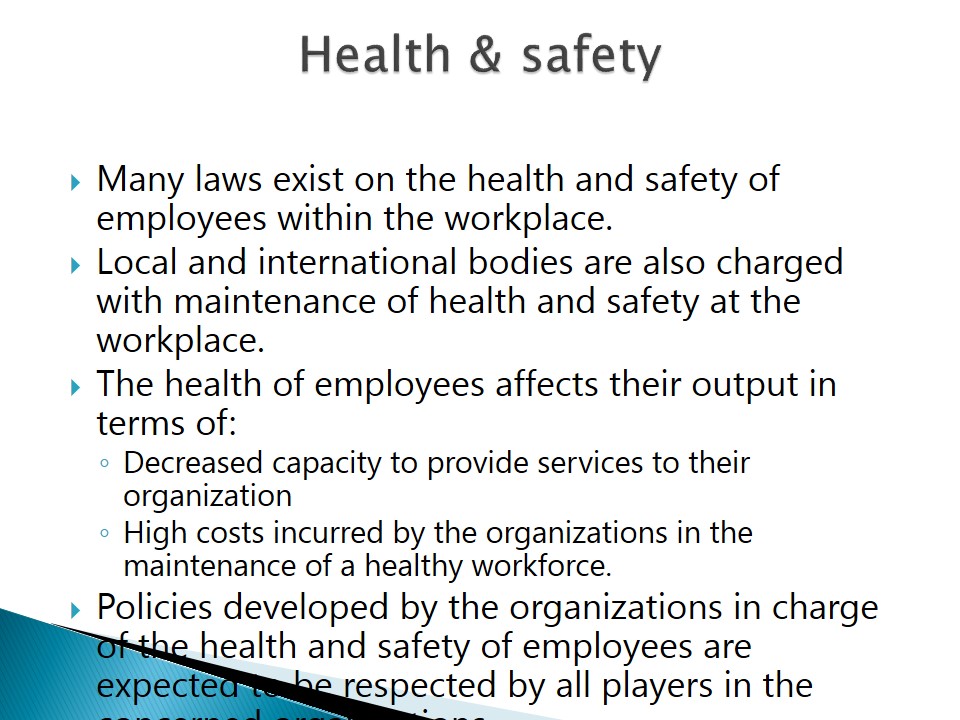
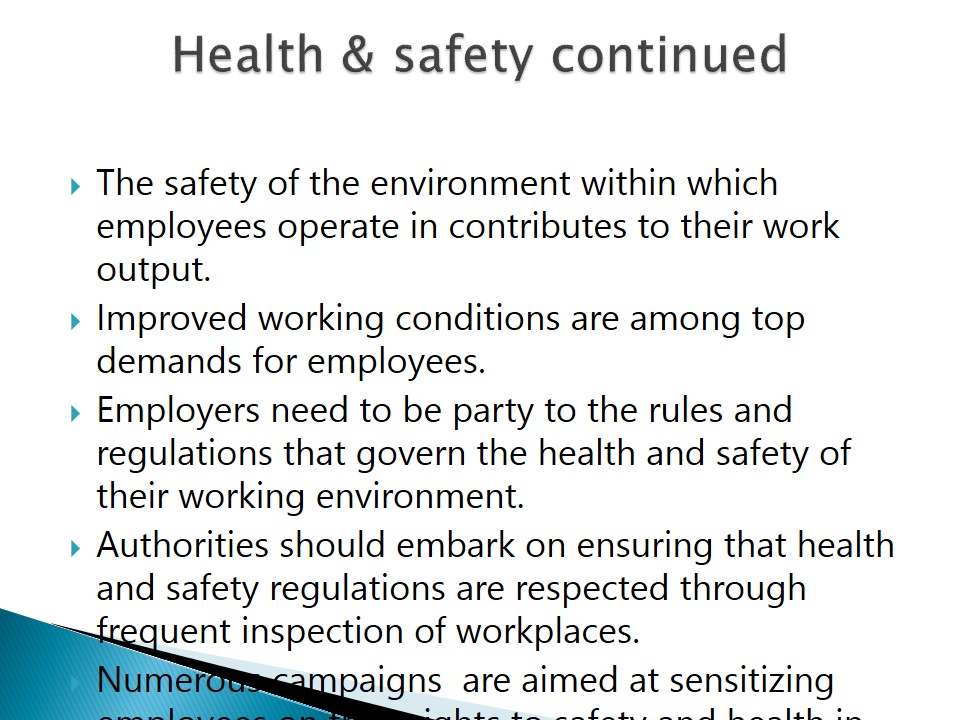
Employee recognition
- It is a normal human desire to get recognition from peers.
- This form of motivation is considered intrinsic.
- Therefore, reward management is one of the key factors in the positive performance of employees.
- Employees are rewarded based on the work that they perform in organizations.
- Privileges such as paid leave, loans, and promotions are ways of employee recognition.
- Such reward plans have a positive impact on employee wellbeing and performance since workers will be willing to give maximum input in the organization.
- Such workers have psychological contentment and hence stress-free in their workplace.
Employee recognition is another of the principles that contributes to their psychological wellbeing in organizations. It is a normal human desire to get recognition from their peers. Employees have an innate desire to obtain recognition at the workplace for the activities that they undertake here. This is one of the forms of motivation that they obtain, and is considered intrinsic motivation.
The recognition of employees takes various forms, with the most common of these being the provision of rewards for their positive performance. Rewards management is, therefore, one of the key factors in the positive performance of employees, ensuring that they are able to perform better than what the organization is able to achieve without them.
According to Mudge-Riley, McCarthy, and Persichetti (2013), rewarding affects the employees positively, ensuring that they are able to improve on their performance. Employees are rewarded based on the work that they perform in organizations, with the most common form of rewarding taking a financial angle. The performance of organizations can be equated to the amount of recognition that it accords its employees (Mudge-Riley, McCarthy, & Persichetti, 2013).
Recognition can also take another shape, with this being the provision of special privileges to employees. Employees who are accorded these privileges such as paid leaves travels and tours, loans, promotions, and contracting are reported to have a better record at the workplace. Therefore, recognition of employees is a major principle in the development of a psychologically healthy workplace.
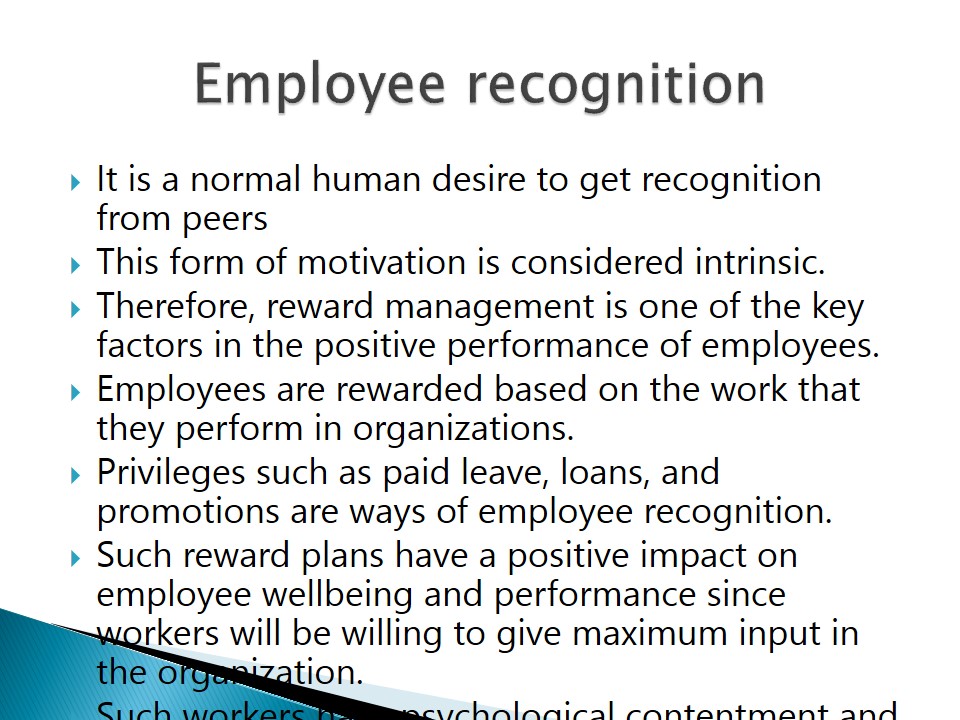
Communication
- Communication is a major principle in the psychologically healthy workplace.
- There are various levels of communication in the workplace, including vertical and horizontal communication.
- The first form of communication is between the employer and employee.
- Examples of communication between employer and the employee include dissemination of information to the employees concerning the expectations that the employer has for the respective worker.
- Employees provide important feedback to the organization.
- Colleagues can be used to train each other.
- Communication may also take the form of a horizontal and vertical descending approach.
- The horizontal dimension in communication for employees is where an employee communicates with a colleague who they work with at the same level.
- The sharing of information and skills between employees ensures that the organization has adequately trained and skilled employees .
- Employers often communicate their intentions to employees based on the organizational goals.
- The management of organizations should involve communication to employees.
- Communication should be simple and clear.
- It should take place on both sides of the divide.
Communication is a major principle in the psychologically healthy workplace. There are various levels of communication in the workplace, and these should be uninterrupted for the employees to be psychologically fit.
According to Zatzick andIverson (2011), employer should constantly communicate to their employees to ensure that they are working within the expectations of the organization. In most of the cases where communication between employees and their employee is good, the organization performs better. Some examples of communication between the employer and employee include dissemination of information to the employees concerning the expectations that the employer has.
An employee is also expected to provide feedback to the employer on certain issues such as the performance of the organization in some areas. When employees provide feedback to their employers, there is a high possibility of improved performance based on the availability of useful information to the employer. According to Zatzick and Iverson (2011), the employee is one of the individual that may provide important feedback to help in the improvement of an organization.
Information that may be provided to the improvement of the organization from the employees is useful to their colleagues, as it may be used to improve on their psychological wellbeing. The overall result is improved psychological wellbeing of the workplace.
Communication may also take the form of a horizontal and vertical descending approach. The horizontal dimension in communication for employees is where an employee communicates with a colleague who they work with at the same level in the organization. This is an important form of communication because it assists in the dissemination of information between the employees.
The interaction between employees results in the improvement of some of the employees since they are able to obtain some skills from their colleagues. The sharing of information and skills between the employees ensures that the organization has adequately trained and skilled employees that propel it to productivity. Since some of the employees join organizations without prior experience, the communication between them ensures that they learn on the job.
Communication is also from the employer to the employees, with this being a descending for of communication. Employers often communicate their intentions to the employees based on the goals within the organization. For organizations whose management effectively communicates to their employees, there is a remarkable success in the productivity. The employers should, however, ensure that the communication is done in a manner that the employees will understand and follow. The employee should be made to feel like an important person in the organization. Hence, communication should be done in an official manner. However, unofficial communication can be conducted where there is a desired effect.
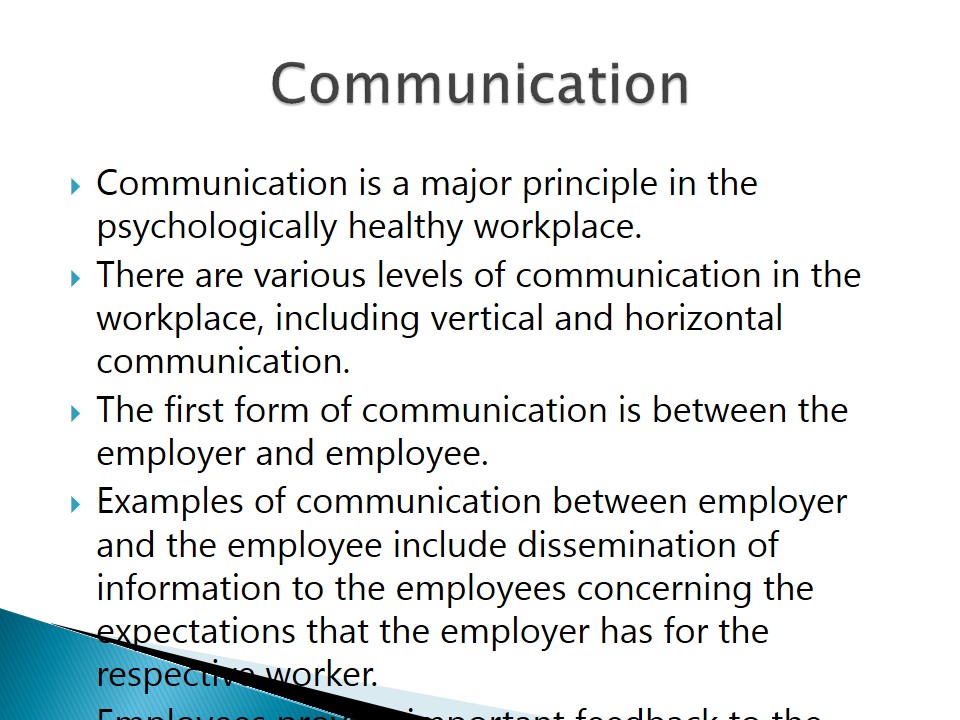

Important Questions
According to NWI’s “Eightfold Path” to a Psychologically Healthy Workplace, (2013), some of the important questions to ask include:
- Is there a sense of zest, “buzz,” and opportunity in the workplace?
- Do employees feel they are valued and treated with respect and dignity?
- Is the organizational culture friendly, inclusive, and supportive?
- Is organizational decision-making fair, transparent, and even-handed?
- Are diversities of all types welcomed and accepted?
- Does the organization face tough questions concerning employee relations?
- Are allegations of mistreatment of employees handled fairly and honestly, even when the alleged wrongdoers are in positions of power?
- Are compensation and reward systems fair and transparent?
For organizations to offer a psychologically healthy workplace they need to consider all the principles that are stated above. Organizations also need to assess whether they are implementing the basic principles in their goal to be competitive. Some researchers developed some questions that are important to answer in the determination of whether an organization has a psychologically healthy workplace. According to these researchers, these questions may be helpful in this assessment.
The first question is whether the employees demonstrate zest when working for the organization. There is also the assessment of the opportunity available at this workplace. The second question assesses whether the employees feel that the organization treats them with value. This is equivalent to the assessment of employee recognition. The third question assesses the organizational culture that is displayed in an organization, assessing whether this is friendly, inclusive, or supportive (NWI’s “Eightfold Path” to a Psychologically Healthy Workplace, 2013).
The fourth question assesses decision making, asking whether the process of decision making in organizations is fair. this is followed by an assessment of diversities in the organization, and how well these are accepted.
The researchers also asks whether the organization in question has any employee relation issues, and whether the organization treats the complaints of employees in a fair and just manner. Answering these questions helps assess the psychological wellbeing of a workplace.
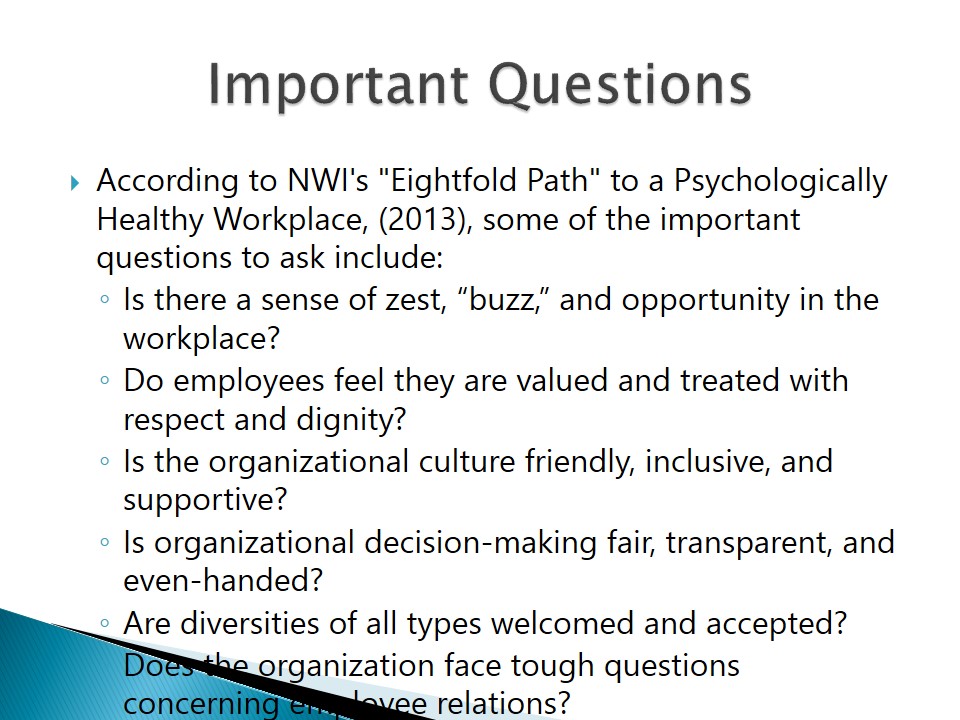
Conclusion
- Psychological wellbeing of the workplace is an important topic in business.
- The main principles of a psychologically healthy workplace discussed in the presentation include;
- Employee involvement;
- Work-life balance;
- Employee growth & development;
- Health & safety;
- Employee recognition;
- Communication.
- These factors have been discussed details in the presentation.
- Any organization that aims to succeed should adopt them.
In conclusion, the psychological wellbeing of the workplace is an important topic in business. Organizations that can maintain a psychologically healthy workplace are recognized as being more successful than their counterparts. This presentation looked at the aspects of a psychologically healthy workplace, providing examples of principles that are applied in this form of workplace.
Some of the important research in this area has been analysed, with this being used to make conclusion of the main principles of a psychologically healthy workplace. The main principles of a psychologically healthy workplace discussed in the presentation include; employee involvement, work-life balance, employee growth & development, health & safety, employee recognition and communication.
It is necessary that employees are involved in the activities of the organization, since they are major players and shareholders. Some of the major activities that the employees may be involved directly in include those affecting them, especially the rules governing the organization.
Employers should also ensure that their employees are able to balance between their work and the other activities. Training and development is another principle that is important to organizations in their quest for a psychologically healthy workplace. Health and safety should also be guaranteed, with communication being another of the great principles of a healthy workplace. These factors are discussed in the presentation, and any organization that aims to succeed should adopt them.
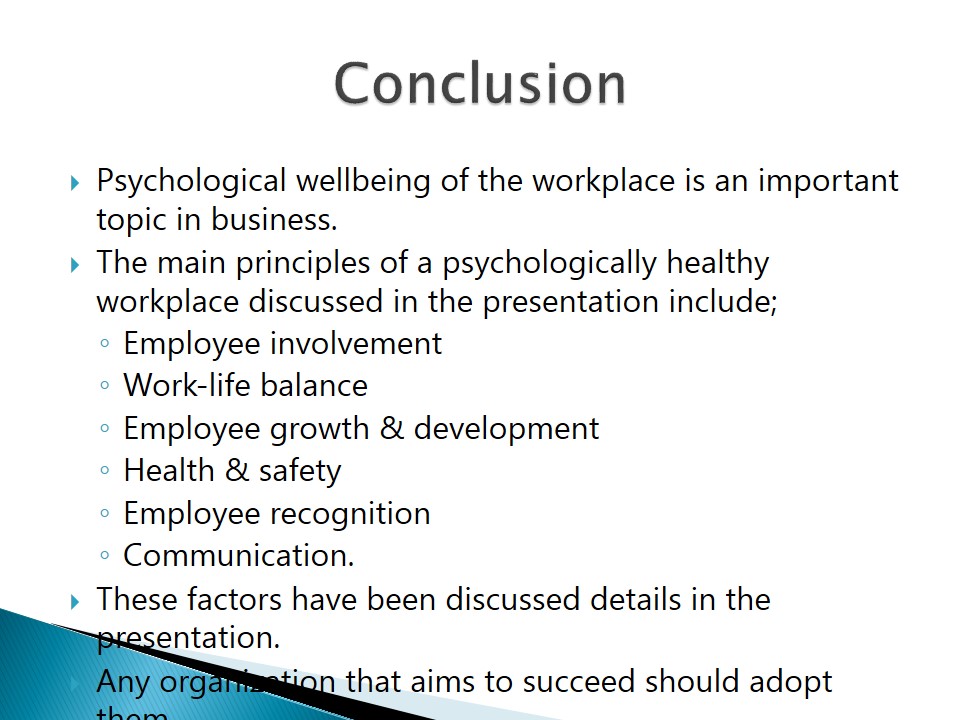
Reference List
Boston, R. E., & Clifford, B. M. (2013). Laws Affecting Wellness Programs and Some Things They Make You Do. Employee Relations Law Journal, 39(1), 30-34.
Churchill, S. A., Gillespie, H., & Herbold, N. H. (2014). The Desirability of Wellness Program and Incentive Offerings for Employees. Benefits Quarterly, 30(1), 48-57.
Mudge-Riley, M., McCarthy, M., & Persichetti, T. E. (2013). Incorporating Wellness Into Employee Benefit Strategies–Why It Makes Sense. Benefits Quarterly, 29(4), 30-34.
NWI’s “Eightfold Path” to a Psychologically Healthy Workplace. (2013). Minding the Workplace. Web.
Zatzick, C. D., & Iverson, R. D. (2011). Putting employee involvement in context: a cross-level model examining job satisfaction and absenteeism in high-involvement work systems. International Journal Of Human Resource Management, 22(17), 3462-3476.